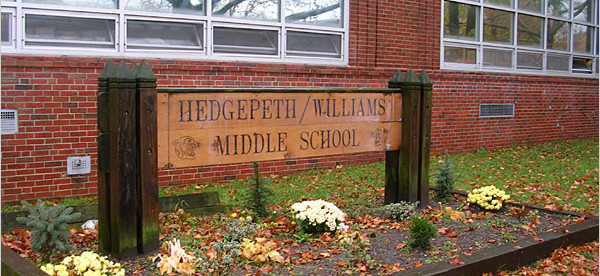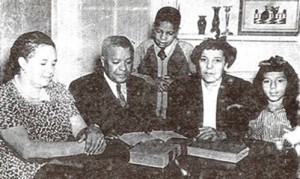Hedgepeth-Williams Case Then and Today

Changing the World One Stride At a Time
The Hedgepeth-Williams case of 1944 was a reconstructive event that changed the New Jersey education system in terms of equality and opportunity. The case examines a racially segregated school in Trenton, New Jersey and the outcomes of two mothers, Berline Williams and Gladys Hedgepeth, and their young children, Leon Williams and Janet Hedgepeth. By fighting for civil rights within that school, these women have spawned many other actions towards creating a desegregated world.
Before the Case
Throughout the 19th and 20th centuries, the United States of America had been facing a harsh reality of discrimination, promoting whites as more elite than blacks. In 1896 the Plessy vs. Ferguson case forced people of different races to literally be separate but equal, or inherently unequal. Many states in the country segregated public and social institutions, primarily schools, despite it being against an 1881 law prohibiting segregation in the school system.
In Trenton, New Jersey, many people worked locally, and as a result of factories simply employing anyone nearby, neighborhoods and districts in Trenton were defined by race. This translates to the schools being populated on the basis of skin color in specific neighborhoods, however, all students in Trenton were required to go to Trenton Central High School due to the high costs of producing school properties, such as fields or swimming pools. For students, being segregated all of their lives throughout the education system and then being forced to come to high school together proposed more room for intolerance.
The Case
Junior High School Number Two in Trenton, New Jersey in 1939 was originally dominated by white students. Many of the black students who lived closer to this school were forced to attend another school, Lincoln School, at least two miles away from their houses, as “Junior 2 “was not built for Negroes” ” (A Brief History Of The Hedgepeth and Williams Decision ). Unfairly and unjustly, Lincoln School did not have half the privileges the white students had, such as better conditions and smaller class sizes. As mentioned earlier, students were segregated until the late teenage years, forcing students to confine to segregation and form a hatred in their hearts for those different than themselves.
Ultimately, Ms. Hedgepeth and Ms.Williams felt ignited to change the inequalities between the two elementary schools, as they wished to send their children to the whites’ school because of its better conditions and closer proximity to their homes. The mothers began the battle of beating segregation in the education system by suing the Trenton Board of Education in 1943 for racial discrimination.
Doctor Paul Loser, a former superintendent of Trenton public schools, played a role in this case as well, as he participated in the case’s final ruling. Loser believed that the schools being separated allowed students to focus better on schoolwork. Moreover, Loser believed that children of the same race better understood one another and therefore keeping children of different races apart helped students academically and socially. Hedgepeth and Williams sought to argue this assumption while fighting for civil rights.
By petitioning the National Association for the Advancement of Colored People, NAACP, the mothers were able to acquire a lawyer by the name of Robert Queen. Queen pursued the case all the way up to the New Jersey Supreme Court. Queen mainly argued desegregating Junior High School Number Two with the seemingly ‘gone but not forgotten’ 1881 law prohibiting racial segregation with regards to education, which clearly had not been enforced strongly enough.
After much deliberation, on January 31st, 1944, the case closed and the mothers won the case allowing for desegregation of Junior High School Number Two! The case officially came to a close with Doctor Paul Loser ruling that Junior High School Number Two was intended to separate blacks and whites, which did indeed discriminate against black students. The New Jersey Supreme Court unanimously did not agree with this, and thus Junior High School Number Two became desegregated. This allowed Leon Williams and Janet Hedgepeth to attend Junior High School Number Two and also forced all schools in New Jersey to not deny any student access to a school on the basis of skin color.
Impacts of the Case
The Hedgepeth-Williams case has created many long-term effects that influenced the pace of the nation’s battle against racism and segregation. First of all, this case started to mute the previously mentioned Plessy vs. Ferguson case, as it became obligatory for schools in New Jersey to not segregate students based on race. In addition to this, the ‘groundwork’ of the Brown vs. Board of Education case was derived from the Hedgepeth-Williams case with the beginning stages of desegregating schools. Following this imperviousness to influence the world to become one, the Brown vs. Board of Education case would also lead to further desegregation within schools ten years later. This case also truly nullified the Plessy vs. Ferguson case, so without the beginning stages from the Hedgepeth-Williams case, the desegregation process would have taken much longer. The Hedgepeth-Williams case also sparked the NAACP’s actions, specifically making persuasive arguments to the Supreme Court in the Brown vs. Board of Education case. Overall, the Hedgepeth-Williams case created many areas of expansion in desegregation, acting as a link to various cases, fueling the NAACP and its goals.
In addition, the Hedgepeth-Williams ruling lead to the 1947 State Constitution which outlawed discrimination in public affairs, which also contributed to New Jersey Law Against Discrimination. This is a major civil rights law that further reduced discrimination in the nation through the New Jersey Department of Civil Science and the New Jersey Division on Civil Rights.
In 1993, Junior High School Number Two was renamed the Hedgepeth-Williams Middle School to recognize the bravery of the mothers who fought for civil rights.
Today
Presently, there is still room for improvement from this case. For example, the Hedgepeth-Williams Middle School today is mostly dominated by black and Latino students, which is ironic considering that the school was once only permitted to white students! Mr. Laurence Fieber, an executive director at the Center for Future Educators at The College of New Jersey, notes that minority students face issues today, such as identity crisis and proving themselves in such situations. Mr. Fieber says that a child from a certain race or ethnicity does not always adhere to the background assumed with that race. Moreover, many black students today are believed to be poor, from rough neighborhoods, or as having a lack of intelligence. This is not always the case, and as a result negatively impacts these students, providing them with less opportunities socially and academically. Daughter of Berline Williams, Thelma Napoleon-Smith says, “Right now, there are too many urban schoolchildren who believe they can’t learn, because they’ve been beaten down so much,” Dr. Napoleon-Smith said. “I think it’s the isolation from each other that feeds that disrespect and anger, because the children realize they’re segregated from other children” (Coyne).
Likewise, this isolation that students feel today has been ongoing, dating to the 1980’s, as Judith Szybist, a former elementary music teacher at an urban school in Trenton, New Jersey also experienced this with her students. Her students of color mostly stuck together, and at times they took an interest in those of different ethnicities. Although segregation in schools has been outlawed, students still feel a lack of community with one another, affecting relationship building skills. Interview With Judith Szybist
These findings correlate with the statistics of demographics in Trenton; in 1920 blacks made up 45% of the city, in 1950, the black population made up 11% of the city, and today nearly half of the population of Trenton is black. (Blackwell) “The blacks of Trenton were not just hardscrabble poor, but skilled factory hands, teachers, lawyers, doctors and other professionals” (Blackwell), proving that as the demographics change, so does the status quo, which resonates with such numbers and facts.
To Conclude
All in all, this case has pervaded the education system and changed the outlook of the future of our children. This case has taught America that everyone deserves an equal opportunity to be the best citizen that he or she can be without judgement of skin color. Hedgepeth and Williams took the first steps towards creating a better future for students of all backgrounds and for all people in general, demonstrating how to fight for one’s beliefs. This theme demonstrates what people can accomplish if they work together, evolving over time into bigger and better triumphs as well as downfalls. How tomorrow’s students will work together to change the world for the better depends on our actions today.
References
Blackwell, Jon. “1943: School Spirit.” The Trentonian. Capital Century, n.d. Web. 19 Nov. 2015.
Coyne, Kevin. “62 Years Later, a Question of What Is Right.” The New York Times. 26 Nov. 2006. Web. 17 Nov. 2015.
Napoleon-Smith, T. “A Brief History Of The Hedgepeth and Williams Decision.” PDF. Web. 16 Nov. 2015.
Photograph References
Coyne, Kevin. 62 Years Later, a Question of What Is Right. 2006. The New York Times, Trenton, New Jersey. http://www.nytimes.com/2006/11/26/nyregion/nyregionspecial2/26njcol.html
Plessy v. Ferguson (1896). 1896. Pbs.org, n.p. http://www-tc.pbs.org/wnet/supremecourt/antebellum/images/plessy.jpg
Schools. N.d. Historic Sites of Trenton, Trenton, New Jersey. http://www.mappler.net/site5/wp-content/uploads/2011/12/image003.jpg


